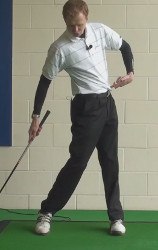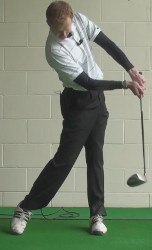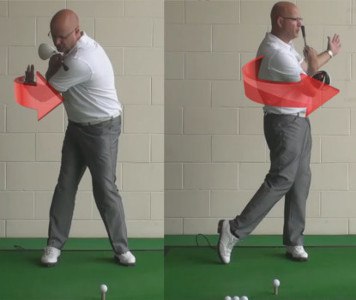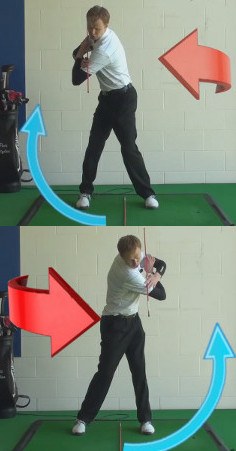
Conventional wisdom says the golfer's chest should directly face the target at swing's finish.
Watch today's pros, especially the younger ones, and you'll see many of them defy this rule.
With the emphasis on hitting the driver as far as possible without fear of the consequences, free swinging is in. That means making an uninhibited, flowing motion all the way to the end.
From a technical standpoint, intentionally stopping your chest from turning on the follow-through can cause your arms to outrace the shoulders and flip the clubhead over through impact, creating a hook.

If you're flexible enough to turn the shoulders left of the target at the finish, don't worry about adhering to an age-old axiom by stopping them abruptly.
Give it a rip and tap into your natural power by rotating as far as you can.

Full Chest Rotation Can Produce Longer Drives
Everyone wants to hit longer drives. The desire for distance is no mystery, of course, as there is a lot to like about possessing the ability to launch the ball well off into the distance. For one thing, longer drives set up shorter approach shots – and shorter approach shots usually lead to better results. Also, if you have the ability to hit long tee shots with your driver, you probably have the ability to do the same thing with shorter clubs like the three wood or your hybrids. That means you can club down on the tee to prioritize accuracy, while still hitting the ball far enough to set up an easy approach.
There are many options at your disposal when you decide to seek more distance off the tee. For some golfers, the first course of action is to shop for a new driver. Yes, you might be able to squeak out a few extra yards by buying a better driver, but this is an expensive way to go. Or, you could decide to work on your fitness, thinking that improved conditioning will help you hit the ball farther. This method can work as well, but it will generally take quite a bit of time for your efforts to be rewarded on the course.
If you are looking for impressive results in the relative short term, you have only one option – improve your swing mechanics. By making a better swing, you should be able to send the ball farther down the fairway in the near future. It isn't going to be easy, of course, as nothing comes easy in golf. Only those who are willing to put in the hard work on the driving range will actually be able to change their swing mechanics for the better. There are going to be setbacks along the way, and you will deal with your share of frustration, but the effort will be worth it in the end when you see just how much distance you have gained.
In this article, we are going to talk about one specific way in which you can improve your swing mechanics. By making a full chest turn – something many amateur golfers have trouble accomplishing – you should be able to add speed to your swing without making any other notable changes. This is a great place to start because of the simplicity of the adjustment. You don't have dramatically change your swing path, your grip, or anything else – just make a better turn and send the ball farther off into the distance. By paying attention to detail and working on the key fundamentals related to this point, you should be able to see some positive results after just a couple of practice sessions.
All of the content below is based on a right-handed golfer. If you happen to play left-handed, please take a moment to reverse the directions as necessary.

The Benefits of a Full Chest Turn
You should never work on anything in your game without first understanding what you have to gain. After all, you have worked hard to build your current golf swing, and it would be a shame to damage that swing in a misguided attempt to get better. Only when you are sure that the changes you are making are for the best should you be willing to head out to the range and get to work.
In this section, we are going to explain what it is that is desirable about a full chest turn. Once you have this information, it will be easy to motivate yourself to work on improving your rotation during the golf swing.
- A longer path. The golf swing is all about acceleration. At the top of the swing, the club is forced to come to a complete stop, as it has to change directions. That means you are always going to be starting with no speed at all from the top of the swing. All of the swing speed that you are going to use to send the ball down the fairway has to be generated between the top of your swing and the moment of impact. There are a number of things you need to do during that time to accelerate the club, and many of those points are beyond the scope of this article. However, one of the simplest things you can do is to make the path longer between the top of the swing and the point of contact. If you make a bigger chest turn going back, the club will be farther from the ball when the downswing begins. That means you'll have more time to accelerate, and the club should be moving faster by the time is reaches impact. You can think of the acceleration of the club just like you would think about the acceleration of a car. If you have a full mile to lay on the gas, you are going to be going faster than if you only have a half mile to accelerate. The concept is the same in golf. Give yourself more distance to accelerate the club and you will have more swing speed through the hitting area.
- Stay connected. You have probably heard about 'connection' in the golf swing before, even if you didn't quite understand what it meant. When golfers talk about being connected in the swing, they mean that their upper and lower bodies are working together nicely. Both halves of the body are in sync, working toward a common goal of launching the ball toward the target. By making a big turn with your chest, you are going to have a much better chance of staying connected properly. If you were to let your chest stop rotating prematurely on the way back, your arms would likely keep going – and your connection would be lost. When the downswing starts, your arms would be stuck behind the rest of your body, and there is a good chance you'd miss the shot out to the right. Even if you did manage to square up the face at impact, you would still be lacking power due to your lost connection. Staying connected is a big key in the golf swing, and staying on track with this point might be as simple as improving your chest rotation.
- Great tempo. If you would like to improve your consistency off the tee, you should be concerned with your tempo above all else. It is great to hit the ball long distances, but those impressive drives aren't going to do any good if they land in the rough. By mastering your tempo, you will be able to harness your power and actually put it to use toward lower scores. When swinging the driver, your chest rotation has a lot to do with the quality of your tempo. By making a full turn with your chest, you should be able to repeat the timing of your swing over and over again. The timing of your swing is more consistent when based on big muscles, rather than the small muscles in your hands and arms. Use your core – including your chest – to drive the swing and let everything else fall into place around that center.
The easiest way to say it is this – you are going to be a better golfer when you make a full turn with your chest. It should be noted that you don't necessarily have to make the biggest turn in the world to be a good player, you just have to make a full turn based on your abilities. Some players are more flexible than others, so don't worry if you can't turn quite as far as your playing partners, or the pros you see on TV. As long as your turn is living up to its potential based on your personal capabilities, you are good to go.

An At-Home Drill
One of the challenges that many amateur golfers face when trying to improve their swings is the fact that they can't get to the driving range day after day to practice. Real life gets in the way of working on your golf game, so you may only be able to get to the range once or twice a month, if that. So, what can you do to improve? Find ways to practice at home.
The steps below outline a simple drill that can be performed in the comfort of your own home. You aren't actually going be using a golf club for this drill, so you don't even need to have enough room to make a swing. As long as you've got a spot to stand up and rotate your body back and forth, you are good to go. If you'd like to try this drill out for yourself, please follow the steps below.
- Find a place to stand where you can safely turn your body back and forth in a golfing motion. As mentioned above, you aren't going to be using a club for this drill, so you don't need to worry about having enough room to actually make a full swing. Once you find a suitable spot to perform this drill, take your stance just as you would if you were holding a club. Make sure you have plenty of flex in your knees, and hold your back in a flat position with your backside sticking out behind you.
- With your stance set, it is time to start the 'swing'. Before you get started, take your arms and place them across your chest, with each hand holding onto the opposite shoulder. In other words, your right hand should be on your left shoulder, and your left hand should be on your right shoulder. Be sure not to stand up out of your stance while moving your arms into position.
- Begin your 'swing' by turning your upper body away from your imaginary target. Of course, this modified swinging motion is going to feel rather awkward, since your arms are going to be across your chest instead of down holding on to a club. With this setup, the swing is going to be all about during your chest properly back and through. On the way back, focus on maintaining knee flex while turning away from the target as far as possible. Many golfers lose knee flex during the backswing, so take care to avoid making this common mistake.
- Once you have turned back as far as you can turn comfortably, change directions and rotate back to the left. Again, it is important that you maintain knee flex while turning your chest aggressively. You are going to rotate to the left all the way to a finish position, where you should be balanced nicely on top of your left leg. With the swing complete, feel free to repeat this simple drill as many times as you would like.
This drill isn't going to feel like much while you are using it, but making it a regular part of your practice routine will pay dividends. You'll get more and more comfortable with creating a full chest turn, and that feeling should carryover even when you are on the range or the course making normal swings. As an added benefit, you should find it easier to stay connected during your real swing, since your arms will be across your chest and always connected in this drill.






